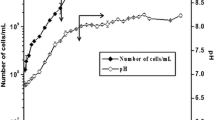Abstract.
Developing new bioremediation processes for soils and effluents polluted by Cr(VI) requires the selection of the most efficient and the most heavy-metal-resistant bacteria. The effects of Cr(VI) on bioenergetic metabolism in two sulfate-reducing bacteria (SRB), Desulfovibrio vulgaris Hildenborough and Desulfomicrobium norvegicum, were monitored using isothermal microcalorimetry. The complete reduction of Cr(VI) to Cr(III) was studied by spectrophotometry and by speciation using a combination of high-performance liquid chromatography and inductively coupled plasma-mass spectrometry. Results revealed that Cr(VI) induces an inhibition of growth with concomitant production of energy, which can be compared to the reaction of the bacteria to a stress such as oxidative stress. Moreover, the sensitivity of bacteria towards this metal is as a characteristic of the strain, which leads to differences in the kinetics of Cr(VI) reduction. The study by microcalorimetry of heavy metal effects on SRB bioenergetic metabolism thus appears an appropriate tool to identify better strains to be used for industrial bioremediation process development.
Similar content being viewed by others
Author information
Authors and Affiliations
Additional information
Electronic Publication
Rights and permissions
About this article
Cite this article
Chardin, .B., Dolla, .A., Chaspoul, .F. et al. Bioremediation of chromate: thermodynamic analysis of the effects of Cr(VI) on sulfate-reducing bacteria. Appl Microbiol Biotechnol 60, 352–360 (2002). https://doi.org/10.1007/s00253-002-1091-8
Received:
Revised:
Accepted:
Issue Date:
DOI: https://doi.org/10.1007/s00253-002-1091-8




